Building links to your site isn’t easy. And it isn’t fun, either.
Especially when it comes to getting the right links for your site. Links from diverse, unique, high domain authority sites that actually move the needle.
These links have the potential to skyrocket traffic, off-page SEO, and rankings.
And that’s why they’re nearly impossible to obtain.
Getting the same old links with the same old tactics from the same old crappy directories isn’t going to deliver bottom-line boosting results.
Not in today’s cutthroat, oversaturated world.
Thankfully, there are a few proven methods when it comes to acquiring the right links with less effort than a boring link building campaign or yet another cold email outreach process.
Here are three of the easiest ways to build better-quality backlinks ASAP.
What Types of Links to Focus on and Why (Data-Backed)
In 2016, Google conducted a question and answer hosted by a Search Quality Senior Strategist named Andrey Lipattsev.
The data that Lipattsev gave us was one of the only clear answers Google has given on top ranking factors.
To sum it up, Lipattsev told us that the top two rankings factors are: Links and content.
In no particular order. What more would you expect from Google?
Essentially, if you want better rankings, you need better content and more/better links.
The tricky part is the link building catch-22. You often can’t get more/better links until you have better content.
Otherwise, it’s too hard to scheme, plan, or scale your way to better links.
This is backed up by research from Backlinko, which studied one million search engine result pages to determine which factors had the most influence on rankings.
Here are the key findings:
- Top-ranking content (1-10 on SERPs) had more links. The #1 post on a given Google search had more links by far. Meaning they dominated the competition with backlinks.
- Total link quantity isn’t all that matters. The top-ranking posts had links from hundreds of diverse websites. Meaning you can’t just get links from a single site and call it a done deal.
- High domain authority (DA) sites are the best links you can get. Top-ranking posts had the highest DA-based links. You need links from the top dogs if you want to rank.
In summation, you need to hit three main factors when looking for links:
- Quantity.
- Quality.
- Diversity.
Still skeptical? Head over to Google and perform a dozen searches for random industry keywords, like “content marketing guide.”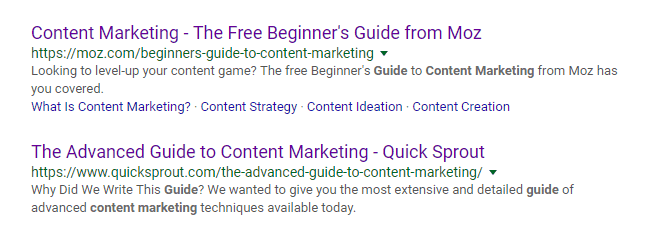
Let’s see how links impact these two specific rankings.
The content on them is pretty much the same. They’re both long and in-depth. We’re talking lots and lots and lots of words. Also, pretty pictures and design.
Meaning one of the only remaining ranking factors left to check out is links.
First, let’s drop the top-ranking post by Moz and plug it into Open Site Explorer to see the backlink profile.
Here’s what that looks like:

Nearly 10,000 backlinks spread across 95 different domains.
Now, check out the second:

967 links spread across 372.
Repeat this for any search, and you’ll likely (almost always) find the same pattern.
If you dig deeper into each backlink profile, you quickly notice the other patterns of diverse sources and high-quality DA sites:

Obviously, these data points aren’t everything. But they’re a lot. They tell you about all you need to know.
Quantity, quality, and diversity drive results.
The only problem is figuring out how and where to get these kinds of links.
1. Guest Blogging for Brand Awareness
Guest blogging has been under fire in the last few years. This year was no different (see: Google Issues a Warning About Guest Posting to Build Links).
In 2014, Google clarified that guest blogging is good, but guest blogging solely for links and SEO isn’t.
If you’ve been keeping up, you already know that it’s a hotly debated topic.
With that being said, you shouldn’t only focus your guest blogging on link building. Meaning your primary goal shouldn’t just be to spam guest posts on every site and grab a fast link.
Instead, you should use it as an opportunity to post content that increases brand awareness, builds credibility, and qualified traffic at the same time.
So, how do you get started guest blogging to build brand awareness when you’ve got no connections?
It’s easy.
Head to Google and search with the following parameters:
site:www.searchenginejournal.com (or any target site) + guest blogging (or guest post or write for)
Doing this simple search will instantly return any page on a given site that talks about guest blogging and how to apply:

Repeat this process for almost any industry site, and you’ll find results:

Most sites will have guest posting opportunities on their blog. So instead of going to each site and scouring the footer or header, just use a parameter.
Don’t just do SEO for SEO sake.
The point is to generate an ROI. And study after study proves that people buy from those they know (or feel like they know).
So yes. You should guest post. No matter what Google says.
Because you’ll get something even more important than a sweet backlink in return: Profit.
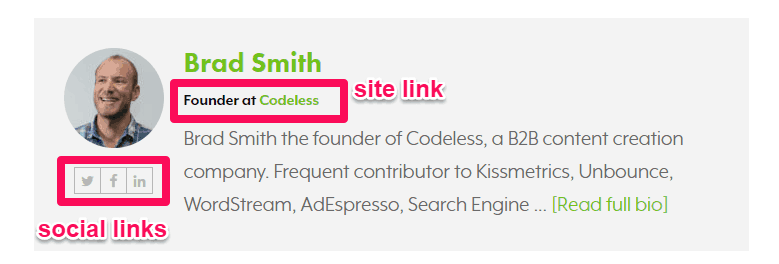
2. Generate More Brand Mentions
The best way to produce more brand mentions and links is by posting better content.
But it can’t be a standard blog post. Not even a long-form post about SEO tips will do the trick.
Those topics are too saturated. They don’t change people’s lives. They don’t shift their world views.
Why do certain posts get tons of links and praise for years to come? They were monumental in the industry.
They drastically impacted the daily lives of SEO professionals. One perfect example includes big, proprietary, data-backed studies.
Drift recently conducted a study where they put their own business on the line to uncover data on forms and live chat.
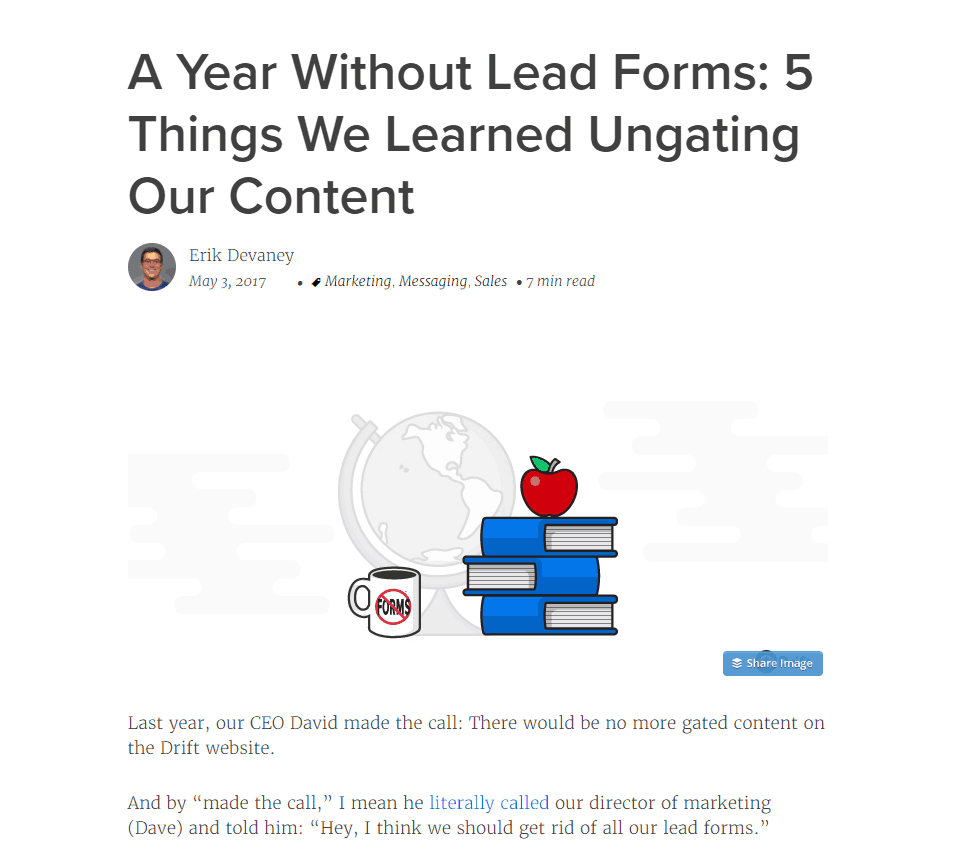
They got links from sites like Neil Patel and CMI. And a Google search for forms now routinely turns up a Drift mention.
Groupon showed us another similar example of this tactic when they risked their own profits to uncover dark traffic.
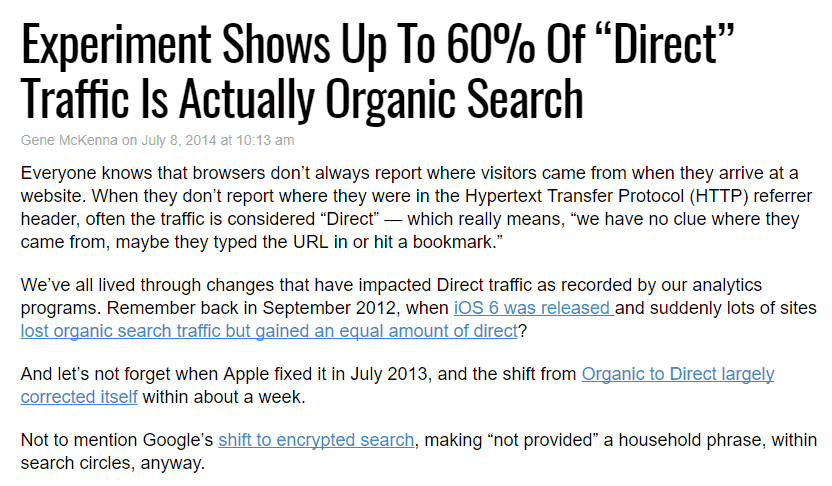
If you search on Google for “Groupon dark traffic” now, you turn up thousands of results mentioning their brand:
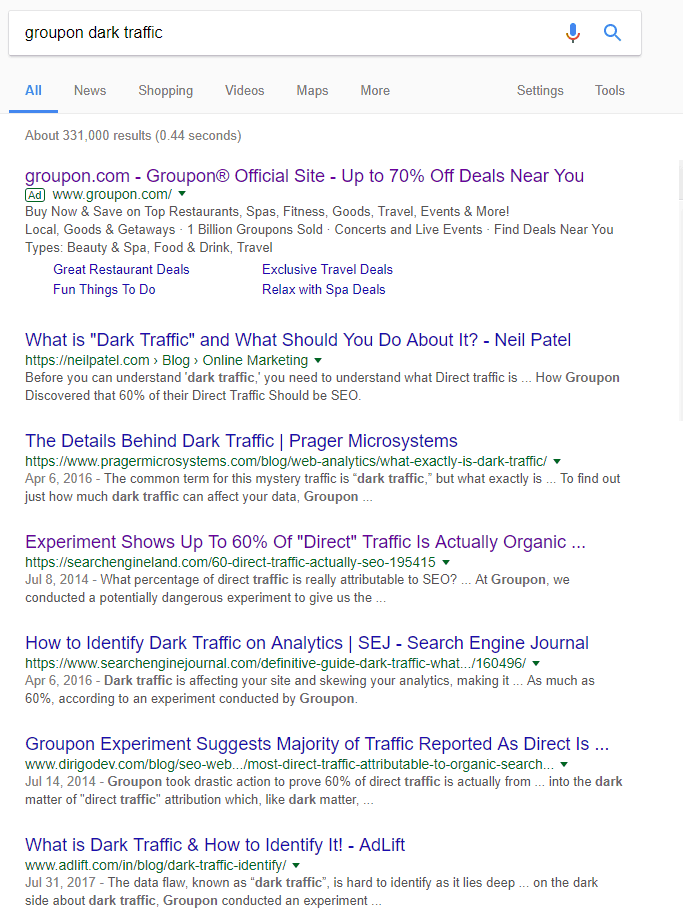
The effects can be massive because the content is literally game-changing.
Do you have a case study in which you used an “out of the box” method to gaining results? Did you uncover new data that was otherwise unknown? Share it with the world.
So, what do you do when you’ve gotten some new brand mentions?
First, you will probably notice that tons of your mentions don’t have a link.
You want to then reach out to these sites and ask them to include your link where your brand is mentioned.
Since they’ve already mentioned you, they will likely have no problem giving you a link.
That’s not the hard part. The hard part is actually getting someone to talk about you in the first place.
3. Mention Influencers in Your Content
You all know and love (hate) influencer round-ups.
They usually look a little something like this: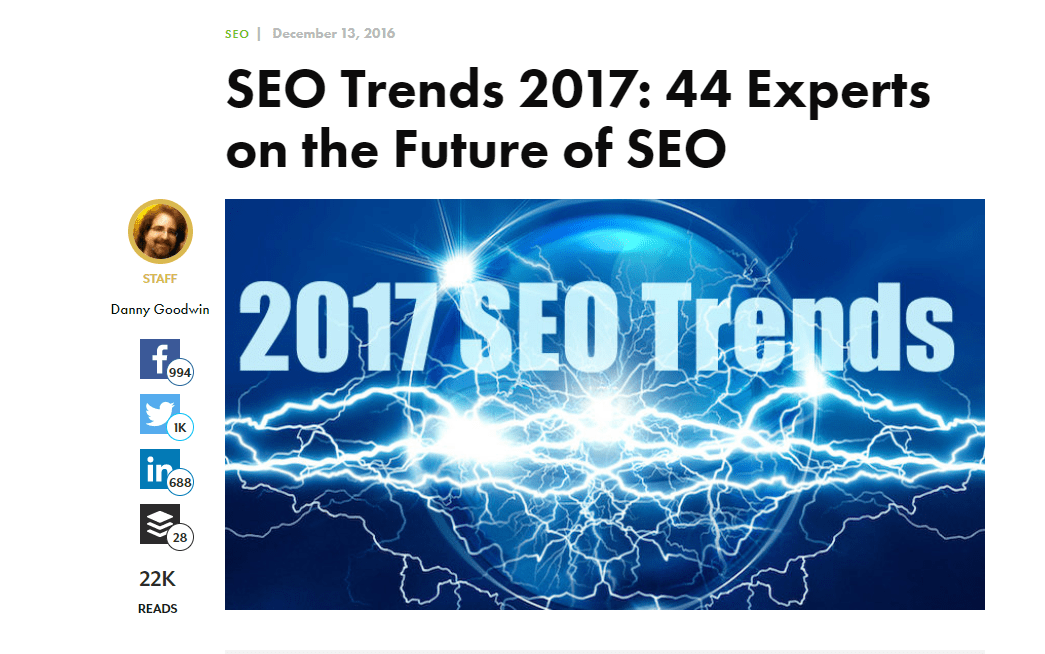
They often compile tons of input from dozens of influencers.
Since they usually reference popular influencers, it’s no wonder that they generate links.
Why? Because they first give a link and a brand mention to each expert involved:
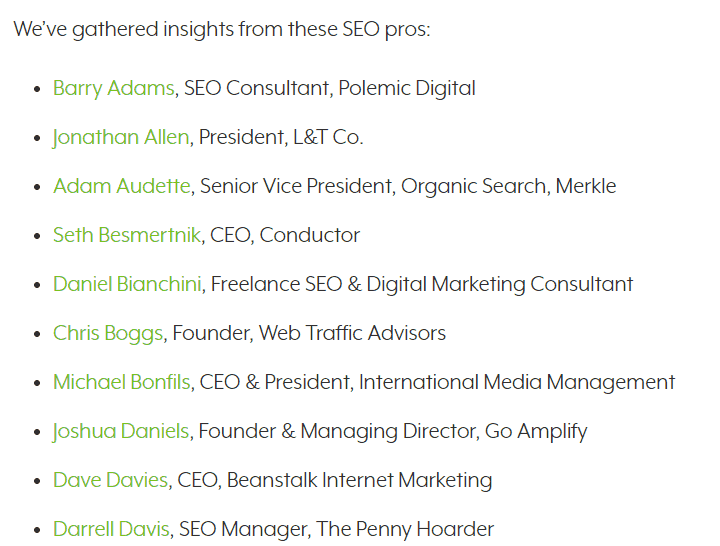
And we all know that reciprocation is key when it comes to just about anything in life.
If you only take (rather than giving too), you likely won’t get very far in life.
These posts often get links from most of the people mentioned.
If you don’t believe me, just take a look at the backlink profile for this post:

That’s a lot of links (from a lot of domains) for a single post. If you inspect each link, you can quickly see that tons of people mentioned in the post are linking back to it.
Why? It’s free promotion for the experts involved. They can drive more traffic to that page by linking to it on their own site.
By doing so, they’ve even shown that they’re an industry expert and further cemented that image in their customer’s’ mind.
Want more links? Write a round-up post featuring experts.
For example, check out how Aaron Orendorff uses round-up style posts to contact and mention influencers and secure links:
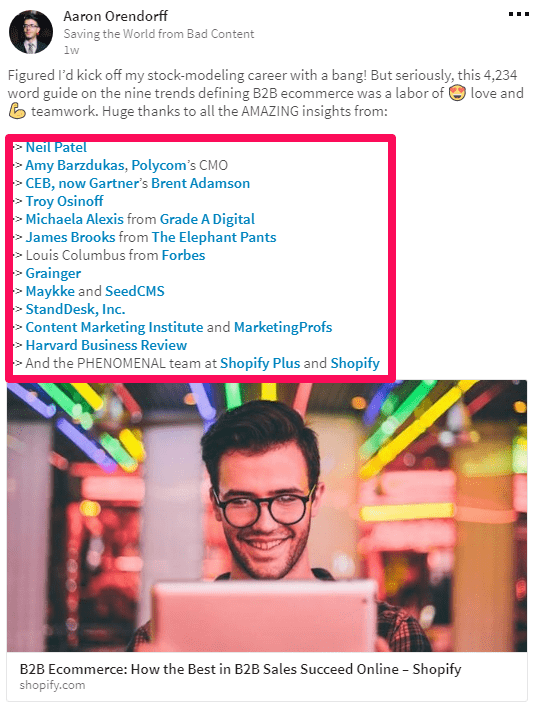
A great way to let influencers know of your new content featuring their input is to simply mention them on social media.
If your content is top-tier, like Aaron’s 4,234-word guide with nine B2B e-commerce trends, you can expect links from the influencers mentioned.
Conclusion
Chances are, you don’t just need any links.
You have enough low-value junk pointing to your site.
Instead, you need the right ones. You need the legit, hard-to-reach ones. The ones that deliver intangible benefits, like branding and credibility, which ultimately lead to more sales.
Guest blogging – no matter what Google threatens – is still one of the best (easiest) ways to get started. The second piece involves generating more brand mentions with atypical content.
Stuff that stands out. Stuff that’s actually remarkable (without just saying it is).
We’re talking the content that is revolutionary in the industry, like Groupon’s dark traffic study or Drift’s year without forms.
Lastly, try mentioning influencers in your content.
Sure, it’s cheap. It’s easy. But it’s also effective.
It gets you on more people’s radar. It helps spread the attention and love. Which then also helps drive new revenue.
More Link Building Resources Here:
- Illustrated Guide to Link Building
- Link Building for “Boring” Industries
- 83 Next-Level Link Building Ideas You Have to Try
Image Credits
Featured Image: klimkin/Pixabay.com
Screenshots by Brad Smith. Taken October 2017.




